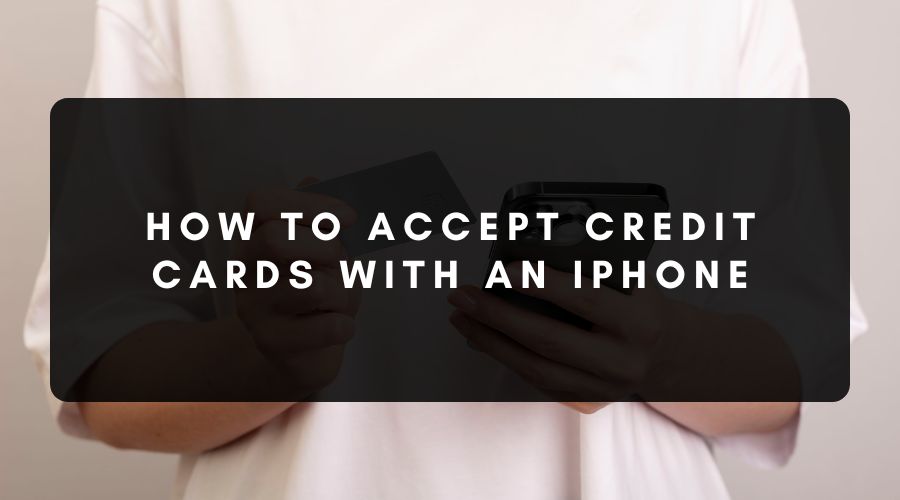How to Accept Credit Cards With an iPhone

Being able to accept credit card or debit card payments with an iPhone is a great advantage for many businesses given the widespread use of smartphones. An iPhone credit card reader provides businesses with the capability to accept payments on the go and offers customers flexibility and convenience.
As customers move toward mobile-centric payments in general, accepting credit cards with a phone may not only be a benefit but necessary for successful businesses going forward. Business owners need to know how this payment method works and the hardware and software that is required for implementation.
How to Accept Credit Card Payments on an iPhone
You can accept credit card payments on an iPhone using a card reader or an app provided by your payment processor. Follow these steps to start processing card payments with your iPhone:
1. Choose a Payment Processor
Choose a payment processing provider that supports iPhone mobile payments. Many businesses already use a near-field-communication (NFC)-enabled point-of-sale terminal for their in-person payments. It is relatively straightforward to begin accepting mobile payments if you partner with a mobile payment processing provider that can fit you out with the required tools.
2. Create an Account
To create an account, you’ll need to provide your bank details and any other relevant information about your business. This information will then be verified and—if everything looks ok—you will be cleared to start accepting payments.
3. Choose a Payment Solution
Payment solutions come in two types: those that require extra hardware and hardware-free solutions.
Hardware-Based Solutions
Solutions using additional hardware include:
- Credit card reader for iPhone: Your payment processor will provide you with a credit card reader that you connect to your iPhone. This allows you to swipe, insert, or tap customers’ credit cards.
- App and terminal: Some payment processors provide an app that facilitates contactless payments. This means customers can pay with an NFC-enabled card. An app can also help you manage transactions, print receipts, and track your sales.
Using an app and reader is simple. Businesses sign up for a merchant services account and download their provider’s app to their iPhones. Providers will often send merchants a credit card reader that connects directly to the iPhone. When the reader is in place, you can accept payments whenever and wherever you are.
Hardware-Free Solutions
Businesses that prefer a hardware-free solution can process payments in more than one way:
- Tap to Pay: Tap to Pay allows businesses to accept contactless payments directly through their mobile device with no need for extra terminals or hardware. Contactless payments can be accepted from Apple products (such as Apple Watch) or non-Apple smartphones with alternative software. You will need to enable this feature on your iPhone settings by searching for “Apple Pay.”
- Virtual Terminal: Virtual terminal payment processing operates online instead of with a physical POS system. Using a virtual terminal involves logging in to your payment processing account and manually entering the customer’s credit card information and the amount payable into the form provided.
It’s possible to connect this technology to a card reader to provide customers with a way to swipe or tap their credit or debit card. This takes away the need to manually key in customers’ data.
Features to Look for in the Best Credit Card Readers
There are some non-negotiable features to look for when it comes to credit card readers for your business. Ensure your card reader has the following:
- The ability to accept every major credit card: Ensure you can take payments from all your customers no matter which card they use.
- PCI Level 1 secured transactions: Security must be an absolute priority. Protect your customers and your business with the highest security levels by ensuring PCI compliance and an EMV certification with immediate data encryption.
- Simple interface: An easy-to-use interface makes life easier for everyone. Intuitive functions will ensure you take advantage of all the features without spending hours on training.
- Manual input: You can enter your transactions manually if your customer’s magnetic strip fails or any other technical issue occurs.
- Seamless connection to your mobile app: A flawless connection between your reader and your mobile app equals hassle-free transactions.
The Security of Accepting Credit Cards with an iPhone
An iPhone card reader is a secure way to complete transactions for the customer and the business. Payments received through an NFC device are encrypted and sent through a secure global payment gateway before being authorised by the card and banking networks.
Which Businesses May Need to Accept Payments on an iPhone?
Many different businesses may need to accept payments on iPhone as an alternative to a traditional POS system.
- Small retail or food businesses: Ambulant businesses are top candidates for iPhone payment processing. Such businesses include food trucks, pop-up shops, and market stalls.
- Freelancers or independent contractors: Freelancers like consultants, designers, and beauticians often meet clients in different locations. Accepting payments on the go makes the transaction process easier for both parties.
- Personal trainers and coaches: Personal trainers or other coaches who offer services at different locations like a public park or a studio often benefit from accepting iPhone payments. Keeping up to date with clients’ payments is much easier if payments are received straight after a session rather than billed later on and paid in person at the trainer’s gym.
- In-person service providers: Tradespeople like electricians, plumbers, gardeners, and carpenters can accept payments on the spot after they finish the job.
The transaction value of mobile POS payments in Europe is expected to grow by 14.88% between 2024 and 2028 with a projected total value of 1.04 billion euros by the end of this period. With a clearly upward trend towards this type of payment, these and many other businesses will benefit from being able to accept payments on a mobile device.
Cost to Accept Payments on an iPhone
The cost of accepting payments on an iPhone depends on your payment processing provider. Businesses will typically be charged a fixed fee as well as a percentage of each transaction.
Pros and Cons of Accepting Payments on an iPhone
The benefits and limitations of accepting payments on an iPhone are the following:
Benefits of Accepting Payments on iPhone
Mobility and Convenience
One of the biggest perks of using an iPhone for payment processing is that it allows itinerant service providers to take payments on the spot. Workers in the service industry or other mobile trades won’t require a fixed point-of-sale terminal in order to be paid.
Speedy Transactions
Accepting payments with your iPhone can reduce transaction time compared to other payment methods like cash or cheques. The merchant also doesn’t need to generate a paper receipt. In industries that are reliant on speed, faster transactions equal shorter queues.
Secure Transactions
iPhone payment systems use robust security technology like encryption and biometric authentication. This safeguards customers’ data. Your payment processor should already offer you fraud detection capabilities, but the kinds of two-factor authentication that are possible with iPhone payments provide another layer of security.
Easy Setup and Use
Implementing and using iPhone payments is relatively straightforward. For a start, there’s little new hardware and no complicated software. You just need a card reader that connects to your mobile device and an app that facilitates credit card processing. This is particularly appealing for platform businesses that enable in-person payments at a large scale because they don’t need to distribute hardware to their business users for them to begin accepting payments.
Digital Receipts
Most iPhone payment systems allow you to send digital receipts via text or email. This saves you the cost and hassle of using a physical receipt printer.
Improved Cash Flow
Payments taken on an iPhone are processed in real-time. This means your business doesn’t need to wait for clients to pay invoices or for cheques to clear. Improving cash flow is particularly important for small businesses and freelancers that are heavily reliant on cash flow from their day-to-day sales to survive.
Flexible Payment Options
Giving your customers the option to pay on iPhone means you can offer them a choice of a range of different payment methods. Customers can choose to use credit and debit cards or alternative payment methods. The ability to accept customer payments from several sources can improve customer satisfaction.
Cons of Accepting Credit Cards with an iPhone
There are two main disadvantages to accepting credit cards with an iPhone:
Technology Issues
Any device is prone to glitches that affect its smooth functioning. This is often frustrating when using your phone for personal matters. However, technology issues with an iPhone can be a major problem when your livelihood depends on it.
An Internet Connection Is Required
Accepting credit card payment on an iPhone requires an internet connection. This could be problematic for businesses in remote areas that have nonexistent or unreliable access to the internet.
Accept Credit Card Payments Anywhere
Businesses can ensure on-the-spot payments while meeting their customers’ needs by accepting credit card payments on their iPhones. More and more businesses will inevitably adopt modern payment solutions to stay ahead of the pack as payment technology advances.
Businesses or freelancers that frequently conduct business on the go are the most obvious beneficiaries of this type of mobile technology. However, new brick-and-mortar businesses such as coffee shops and retail stores can also take advantage of this simple technology to get their payment system up and running with a minimum of hardware or hassle required.

